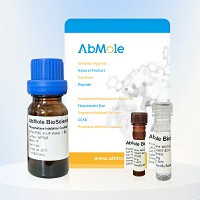All AbMole products are for research use only, cannot be used for human consumption.

Chemokine (C-X-C-motif) ligand 6 (CXCL6) is a small cytokine in the CXC chemokine family. It is a potent neutrophil chemoattractant and activator, and it shares broad similarities with other CXC chemokines such as IL-8 and ENA-78. CXCL6 promoted the release of MMP-9 from granulocytes, indicating its potential role as an inflammatory mediator. It functionally uses the IL-8/CXCL8 receptor to chemotaxis neutrophils, but this is structurally related to the epithelal-derived neutrophil attractor 78 (ENA-78)/CXCL5. The human CXCL6 gene has been cloned and physically mapped to the CXC chemokine locus on chromosome 4. Mature human CXCL6 is a 75-amino acid (AA) protein with a predicted molecular weight of approximately 8 kDa. The homology of human CXCL6 to mouse and bovine CXCL6 was 60% and 67%, respectively.
Recombinant Human C-X-C Motif Chemokine 6 expressed the target gene encoding Gly38-Asn114 with a 6His tag at the C-terminus.
Lyophilized from a 0.2 μm filtered solution of 20mM PB, 150mM NaCl, 5% Trehalose, 1mM EDTA, pH 7.4.
| Form | Lyophilized powder |
| Solubility (25°C) | Reconstitute the lyophilized powder in distilled water to a concentration not less than 100 μg/mL. |
| Storage | Stored at ≤ -20°C, stable for one year after receipt. Reconstituted protein solution can be stored at 2-8°C for 2-7 days and at -20°C for 3 months. |
| Related Cytokines and Growth Factors Products |
|---|
| Recombinant Human GDF-15 Protein (HEK293 N-hFc)
Growth-differentiation factor 15 (GDF15), also known as MIC-1, is a secreted member of the transforming growth factor (TGF)-β superfamily. GDF-15 has a role in regulating inflammatory and apoptotic pathways in injured tissues and during disease processes. GDF-15 overexpression arising from an expanded erythroid compartment contributes to iron overload in thalassemia syndromes by inhibiting hepcidin expression. |
| Recombinant Human FGFR1 Protein (HEK293, C-His)
FGFR1, also known as CD331, is a full-length representative protein consists of an extracellular region, composed of three immunoglobulin-like domains, a single hydrophobic membrane-spanning segment and a cytoplasmic tyrosine kinase domain. |
| Recombinant Human FGFR2 Protein (HEK293, C-His)
FGFR2, also known as CD332, acts as cell-surface receptor for fibroblast growth factors and plays an essential role in the regulation of cell proliferation, differentiation, migration and apoptosis, and in the regulation of embryonic development. FGFR2 plays an essential role in the regulation of osteoblast differentiation, proliferation and apoptosis, and is required for normal skeleton development. It also promotes cell proliferation in keratinocytes and imature osteoblasts, but promotes apoptosis in differentiated osteoblasts. |
| Recombinant Mouse BMP-4 Protein (E. coli, C-His)
Bone Morphogenetic Protein-4 (BMP-4) is a critical signaling molecule required for the early differentiation of the embryo and establishing of a dorsal-ventral axis. BMP-4 is secreted from the dorsal portion of the notochord, and it acts in concert with sonic hedgehog to establish a dorsal-ventral axis for the differentiation of later structures. |
| Recombinant Human Coagulation Factor X (HEK293, C-Fc)
Coagulation factor X, belongs to the peptidase S1 family. Coagulation factor X is initially synthesized in the liver. Coagulation factor X is a vitamin K-dependent glycoprotein that converts prothrombin to thrombin in the presence of factor Va, calcium and phospholipid during blood clotting. |
All AbMole products are for research use only, cannot be used for human consumption or veterinary use. We do not provide products or services to individuals. Please comply with the intended use and do not use AbMole products for any other purpose.


Products are for research use only. Not for human use. We do not sell to patients.
© Copyright 2010-2024 AbMole BioScience. All Rights Reserved.
